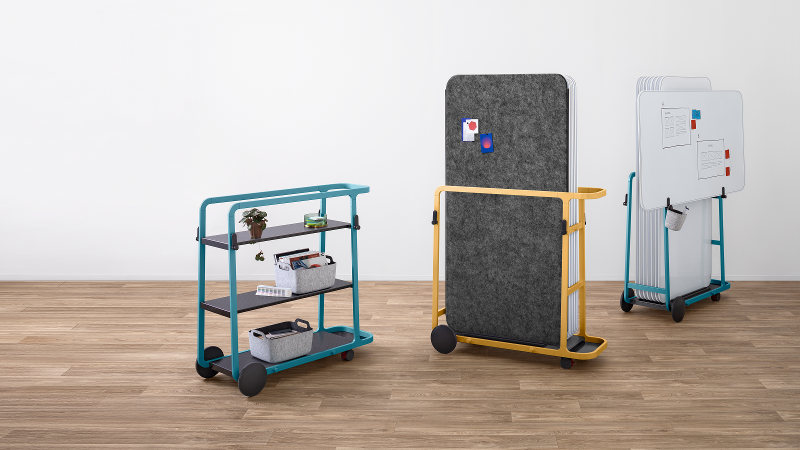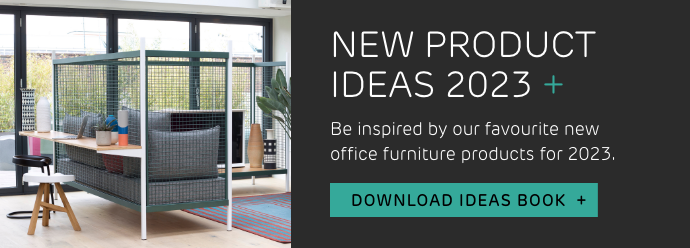So you’ve decided to refurbish your office space. Perhaps you’re downsizing, relocating, or just looking to reimagine your workplace to suit new employee expectations post-Covid.
Whatever your motivations, any office refurbishment project can be a time-consuming and expensive process. Before you dive in, here’s five things to think about when designing and furnishing your workplace to ensure you get the most out of your investment.
1. Leveraging your furniture assets
When refurbishing your office, it makes sense to look at your existing assets first. A furniture audit will help you to understand your current portfolio and identify what you want to keep, what can be repurposed, and any additional items you may need.
Too often, old furniture items get cast aside to make way for new products with little consideration of how those pieces could be adapted or refreshed to suit the new working environment.
Many office furniture products today are built with a circular economy mindset. Items are built using few but high-quality materials that are designed for durability and second life.
So before writing off a piece of furniture, consider if it can be reused or repurposed;
- A good quality but tired looking chair could be reupholstered or parts replaced to bring it back to life
- Casters can be added to desks and screens so they can be adapted to suit employees as they move between different modes of work
- Beams or leg frames can be removed from desks to turn them into collaboration tables.
%20(1)-jpg.jpeg)
And what to do with anything you don’t need?
Your unwanted items could be stored, sold, donated or recycled to release the value and real estate space they occupy. Your office furniture consultancy will be able to help and advise you on your options. Some will offer end of use schemes where furniture is brought back or otherwise re-introduced into the supply chain, enabling you to dispose of your surplus assets in socially, economically and environmentally responsible ways.
2. Designing for employee needs
The work from home experiment bought about by Covid has led to new expectations from the workforce on what they need to be happy and productive. These needs and expectations will need to be top of mind when planning your new workspace.
Choice is king, as employees seek spaces that allow them to work how they want, when they want.
The trend towards hackable spaces was growing before the pandemic, but the need for more control over the working environment is greater than ever now people have experienced the autonomy of working from home.
The post-Covid office will be a dynamic hub for collaboration, and appropriate steps will be needed to make it functional for such gatherings. At the same time, individuals will also need spaces for 1-2-1 and solo work.
Flexible furniture solutions that can morph and change with the changing needs of workers throughout the day will be key. The Steelcase Flex range, for example, includes moveable acoustic screens that can create quieter spaces on demand, as well as moveable carts, lightweight technology and portable power packs so individuals can work where they need to.

Collaborative spaces also need to be designed with ‘virtual colleagues’ in mind. 68% of global organisations are planning to experiment with hybrid work. If you’re one of them, bridging the gap between mixed presence teams will be crucial for enabling workers to collaborate effectively.
Assets to consider include large flat-screen monitors on moveable ‘easels’ that improve the presence of remote participants, virtual whiteboards so everyone can interact in the same space, as well as the use of acoustic screens to block out noise from the rest of the office.
3. Wellbeing first
The coronavirus crisis has pushed wellbeing to the up of the agenda. To support physical wellbeing, products such as desks screens, partitions, hygiene stations and air filtration systems can help create a secure environment for your people.
At the same time, organisations are becoming more aware of the need to support the full range of neurodiversity in employees, with one in seven people having neurodiverse conditions such as autism, dyslexia and ADHD. Creating work environments that allow all employees to thrive can offer you a distinct competitive advantage. Not only will employees be more comfortable and more productive, but it will help your business to attract and retain the best talent.
And how about spaces where people can go to relax and rejuvenate?
Contemplative spaces, relaxation zones and meditative environments are likely to become more popular post-Covid. Soft furnishings in these spaces aid both comfort and creative thinking, so workers can go back to their tasks feeling enriched and recharged.
-jpg.jpeg)
4. Doing it sustainably
The global conversation around environmental, social and corporate governance (ESG) is driving companies to embed more sustainable practices in their business going forward. What better place to start than with your office?
The good news is that sustainable furniture options are increasingly becoming the best commercial option.
Building standards, certifications and rating systems can help guide you on best practices for designing a sustainable workplace. The likes of BREEAM and SKA promote the use of furniture items with EPDs (Environmental Product Declarations) and low or zero VOC (volatile organic compounds) emissions. A good office furniture consultancy will also be able to advise you on choosing sustainable products.
5. Managing the transition
Whether you’re moving to a new building or refurbishing your existing space, you’ll want to ensure that the project runs smoothly and with minimal disruption.
An office furniture consultancy can manage the process for you, including:
- Dismantling, moving and re-installing furniture
- Auditing, tagging and tracking assets to ensure they end up in the right place
- Moving fixed IT assets, desktop computers, monitors and other peripherals
- Buy-back schemes or recycling of unwanted furniture items
Summary
The work environment has a direct impact on the wellbeing, productivity and creativity of your employees, and as a result, the success of your business. Any office refurbishment project requires a well thought out strategy. What do you want to achieve with your new office space? What does the space need to look like in order to help you reach those goals? Which of your existing assets can be reused or repurposed? And what additional products might you need?
A good office furniture consultancy will act as your guide, a partner, in helping you to navigate change and transform your workspace for the better. They will support you through every stage of the process, from strategy development to design, installation, and after-sales support.
Find out how IE can help you with your office refurbishment here.










